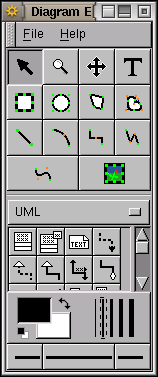|
The main dia
tools window allows you to create new canvases,
select the tools you wish to use, and set your preferences. The
application preferences are accessed through
File-->Preferences. Options
include compression of saved files, the default size of new canvases,
and characteristics of the grid displayed on the canvas (including its
visibility and whether objects snap to the grid). These choices take
effect from the next canvas that is opened (but not for currently
opened canvases) and are saved in /.dia/diarc.

The first step in drawing is to start a new canvas with
File-->New Diagram. You then
select objects, lay them out on the canvas, add the lines to connect
the objects, and add relevant text.
The tools available on the main dia
window fall into four distinct
areas. The Pointer and Standard Shapes generally occupy the top half
of the window. The Sheets area is next with an option menu that may be
showing UML as the currently selected sheet. Below this (in
a scrollable window if required) are the actual shapes provided by
this sheet. The next area selects the pen colour and type. Finally,
line types are selected with the final row of buttons.
If you are unsure of the purpose or intent of a shape or button simply
move the mouse pointer to hover over the corresponding button and a
tooltip will remind you. Click the left mouse button on the tool
button to activate the tool.
Copyright © 1995-2006 [email protected]
|
